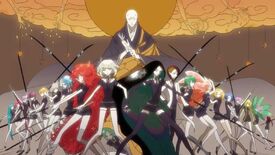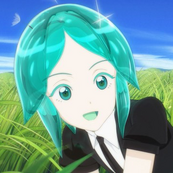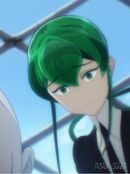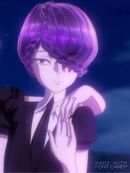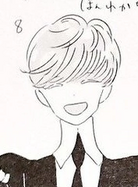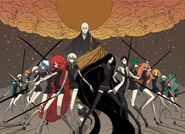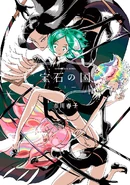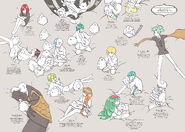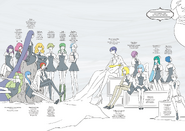| Gems / 宝石 | |
|---|---|
| Info | |
| Leader | Kongo-sensei (Earth Gems) Phosphophyllite (Moon Gems) |
Gems (宝石, Hōseki) are an immortal, humanoid species made of gemstones that inhabit the land of the world. There are 28 gems on the island at the start of the story.
Characteristics
The Gems take the forms of humans, but with bodies made of polished gems that differ depending on the material they are made of. Most of them have hair, eyes, and nails the same color as their gemstone bodies. During the day, they apply white powder to their bodies to simulate skin. While their hair may look solid, it can be manipulated similarly to human hair (cut, tied, braided, etc). Apart from the adult Kongo-sensei, their appearance takes the form of androgynous young teens.
The Gems are born at the Shore of Nascency, where crystals from the sea rise up over eons. Some of these crystals fully develop into a humanoid form and become a Gem, while others never reach that stage and simply fall back to the earth as inanimate crystals. Kongo corrects each Gem with a chisel after they are born on the Shore of Nascency, removing asymmetries to make all the gems equal. The Gems appear to be lacking sex characteristics, making them sexless. Their outer body functions much like a human's, and they appear to be able to use all five senses, though they are unable to detect temperature. They can ram into each other to determine another Gem's hardness.
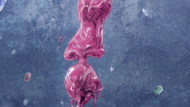
A Ruby that failed to fully form into a Gem.
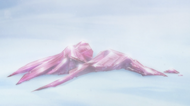
The same gem falling onto the beach.
Each Gem is differentiated by their hardness and toughness. Some Gems can be very delicate, making them unsuited for battle, while others are very hard and durable. They use a scale of hardness that is equivalent to the Mohs scale, which is based on the ability of one mineral to scratch another, with 1 being the lowest and 10 being the highest. Toughness or brittleness is the measure of how easily a Gem breaks and is more complicated to determine. For example, Diamond has the highest hardness of 10, but is second-class in terms of toughness. Gems like Jade can have an average hardness of 7, but have excellent toughness. One way to sum it up is to consider hardness the level in which a Gem can break other objects, while toughness is the level in which they themselves can resist being broken.
The Gems carry microscopic organisms called "inclusions" (インクルージョン) in their bodies, which energize them by absorbing light. Due to this mechanism, Gems need sunlight to survive, forcing them to sleep at night and hibernate in winter. Furthermore, inclusions allow Gems to be put back together when shattered, making them technically immortal. The oldest known Gem is Kongo-sensei (at least 3600 years old), with Phosphophyllite as the youngest Gem at the start of the series, being only 300 years old.
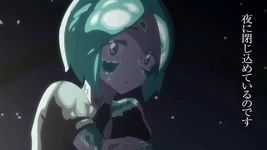
A Gem after being scraped.
Their memories (and presumably their personalities) are stored within the gemstone that makes up their bodies. As such, losing any part of their body will result in some memory loss. Their lost body parts can be replaced with other material as long as they are compatible. The hair of the Gems, however, contains little-to-no inclusions making losing it not a serious problem.
They can speak underwater but their powder skin can wash off, requiring reapplication. Salt-water (as in the sea and the school's pond) can damage some gemstones so anti-salt resin is required. The waves are also dangerous since the pressure can shatter their body. Acid and heat can also be dangerous to Gems, as demonstrated when a giant slug digested one of them. In this case, the Gem who was digested was incorporated into the slug's shell as fragments and was able to be revived. It is unknown if Gems can be truly dissolved and thus killed. The poison from Cinnabar can also harm Gems as any part of their body that comes in contact with it will be tainted and blocked from the light, preventing the inclusions inside from feeding. These parts must be scraped off the body.
In critical situations, some Gems can fix themselves without the assistance of resident doctor Rutile if their fragments are mostly together and in one place, though they do not do as good a job as Rutile. It is shown that they still can speak when they're broken as long as they are mostly intact, but will lose consciousness when left in mere fragments. Intense emotion can cause them to suddenly fracture. Being broken or melted is described as feeling very sleepy and being paralyzed. Being hit by another Gem appears to make them uncomfortable, as shown when the Amethyst twins headbutted one another, much to Phosphophyllite and Yellow Diamond's discomfort.
History
As told by Kongo-sensei
According to him, the planet was broken after being visited by a meteor for the sixth time. It gave birth to six moons, leaving it an emaciated shadow of its former self. There was nothing left but a single beach, so all life fled to the ocean. Some creatures who had flourished when the moon was still one were too slow in their escape and sunk into the seas. They were eaten by tiny creatures on the ocean's floor, turned into inanimate objects, crystallized over the ages, and rose to the surface at the Shore of Nascency. In rare instances, this leads to a Gem successfully taking form.
The Gems have to defend themselves against the endless number of hunters from the Moon - the Moon People - who abduct the Gems and, apparently, use them as ornaments. At the start of the story, no Gem has ever returned from the Moon.
As told by Ventricosus
According to the Admirabilis' legend, there once were creatures called humans who lived on and preserved the land until it broke five times. When it broke the sixth time, they entered the seas. It's said that there, they split into three parts; the spirit, the flesh, and the bone (or evolved into different three species and lived on). The Admirabilis are said to be the flesh, inheriting the ability to expand and pass down their knowledge; The Gems the bone, returning to the land having made a contract with another living species and gaining the ability to live for millennia; and the Moon People as the spirit, forever wandering, attempting to regain its flesh and bone.
Culture
The Gems use male pronouns (彼(kare)/he; お兄様(onii-sama)/older brother; 弟(otouto)/younger brother) to refer to each other. While most of them also use masculine forms of "I" (僕/boku, 俺/ore), their personal speech patterns vary greatly between masculine and feminine. Even so, they don't seem to be aware of gender and/or sex characteristics, as seen when Phosphophyllite asks Ventricosus about her breasts, referring to them as "two water bags". That instance aside, gender is never brought up or explained within the work. Whether they see themselves as male or genderless is left unconfirmed. Most call each other with various nicknames, but all call Kongo "Sensei" (Teacher).
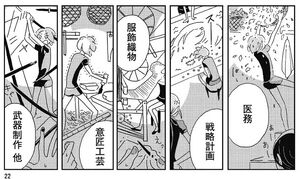
The Gems live in a spacious school building with a large bell that they use as a signal. The school uses jellyfish as lighting instead of electricity-based technology or fire, neither of which have been shown in the series. They also use traditional tools for hand-spinning textiles and crafting. They're able to produce textiles by themselves, craft tools, make papers and pencils, and have developed science in medicine and herbs (but gem related). Kongo-sensei teaches the young Gems anything they need to know, though the school does not seem to hold any organized classes. Each Gem is entrusted with a role or roles they're suited for, though almost all of them are fighters and have patrol duties during the day. The different roles shown so far include patrolling, health and medicine, crafting, smithing, tailoring, and strategy and planning. They have their own dorms to sleep in at night, and hibernate in one big room in the winter. In their free time, they may play card games, which were either taught to them by Kongo-sensei or created themselves.
Every time the Moon People come, the Gems must ring the bell to alert everyone of the situation (for instance, six rings tells the Gems to stand by and await further orders). Patrol teams usually consist of two Gems, which leaves one to fight and the other to keep watch or run back and alert Kongo-sensei in the case of an encounter. Usually, after the bell is rung, all the Gems come together with him, though he will always disperse the Moon People with his own powers alone. Every morning they have morning assembly, which is especially important for those patrolling that day.
Most Gems use the international/English name of gems for their own names, but Japanese is used for 'Kongo, meaning Adamant, and 'Shinsha' for Cinnabar. Except for Kongo-sensei, who wears a Buddhist monk kimono, the Gems wear the uniforms sewn by Red Beryl for their day-to-day lives. Their winter hibernation clothing shares similarities with female Japanese kimonos. Red Beryl, who in charge of clothes, tends to like things feminine and frilly.
Due to their unique structure, they have no concept of true death and tend to cherish short-lived things like hemp and paper. They tend to think being mortal like other organisms is an inconvenience, and some (like Bort) believe that Gems are superior. They consider it unethical for the Moon People to kidnap their brothers and use them as tools. Since they are technically immortal, there is a chance for kidnapped Gems to be returned from the Moon, even if it means doing so piece by piece. Some gems do not show too much emotion over the loss of their brothers, perhaps due to the fact that they can be returned. Though others may become stricken and obsessed over their kidnapped siblings, especially if they were involved in the raid that caused it to happen and blame themselves.
Excluding Kongo-sensei, the Gems are not informed and have no idea about humans. Kongo-sensei occasionally refers to human characteristics, such as Phosphophyllite's tears, as "the dregs of an ancient species". The Gems don't seem to show much curiosity about things beyond their own tasks. That being said, they seem to have a fondness for flowers. They gather bouquets during sensual moments, have hand-made flower bowls and grow a lot of various plant and flower species beneath the school roof, presumably growing and caring for them. When Phos got golden hands, they shaped the gold into flowers to show the other Gems that the hands are not dangerous.
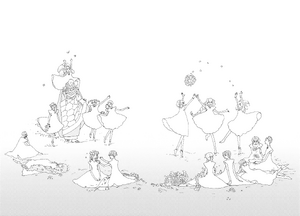
They are really caring towards each other and will go to great lengths to defend each other against the Moon People, even sacrificing themselves if necessary. They all unconditionally love their only teacher and are commonly seen doting over him. Kongo-sensei essentially acts as a parental figure towards the Gems, having raised and educated every single one of them from birth. Despite his stoic demeanour, Kongo, in turn, loves the Gems as well and will occasionally them affection as if they were his own children. The Gems have been seen requesting hugs, trying to win his attention, or displaying jealousy over other Gems who receive it.
List of known Gems
Gems on Earth at the start of the Story
At the story's introduction, Kongo-sensei states that there are 28 Gems. This was later stated by Cinnabar as well, though only 27 individuals Gems have been seen, even after including Kongo-sensei himself, the Amethyst twins, and Ghost Quartz's other personality Cairngorm. It is currently unknown who the remaining Gem(s) are.
Gems on the Moon at the start of the story
Gems born after the beginning of the story
Trivia
- In mineralogy, an inclusion is any material that is trapped inside a mineral during its formation. This can include other minerals or metals, plants, or animals. Insects found within amber gems are a common example of an inclusion. In gemology, an inclusion is a characteristic enclosed within a gemstone, or reaching its surface from the interior. According to Hutton's law of inclusions, fragments included in a host rock are older than the host rock itself.
- While inorganic by nature, it is shown with Phosphophyllite and Yellow Diamond that Gems are susceptible to mental illness.
- Kongo-sensei is the only adult in appearance among the Gems.
- Kongo-sensei/金剛先生 and Cinnabar/シンシャ are the only Gems who have Japanese names instead of English in the original Japanese version. Though note that "Shinsha" is written in katakana like all the other Gems' names, rather than its normal kanji (辰砂).
- When Phos snuck onto the Moon, the Moon People examine them and compare Phos to the "Apophyllites" that they gathered before. There has been no other reference to a Gem called "Apophyllite" so it is unknown if this is referring to another Gem or simply a term for a class of gems.


